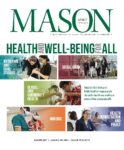When George Mason University anthropology major Bryan Dalton stepped off the plane in Nicaragua last summer, he was quickly whisked away to help save an archaeological site on the brink of destruction.
It was June in the Central American country, and heavy tropical rains had flooded the Huellas de Acahualinca Museum, endangering the 2,100-year-old footprints encased in volcanic ash that the museum is built around.

Students on a dig with Mason anthropology professor Justin Lowry had the opportunity to help save an historic landmark in Nicaragua. Photo courtesy of Archaeology in Chiquilista
“The wall between the site and the earth failed. It just poured mud and sand and dirt in there to the point that you wouldn’t have even known [the site] was there,” Dalton says.
Dalton was in Nicaragua to work on a different archaeology dig with George Mason anthropology professor Justin Lowry, but the flood meant Lowry first needed the students to help tackle this emergency. The group was asked to help with the museum recovery project by Clemente Guido Martinez, director of the Managua City Mayor’s Office of Historic and Cultural Patrimony.
“This was my first chance to taste what actual fieldwork was like,” says Dalton—and to save a national treasure.
After completing their critical mission at Acahualinca in Managua, the students traveled to their original destination—Chiquilistagua, where Lowry runs a field school. Lowry, who specializes in archaeological anthropology, takes students to Nicaragua during most summer breaks and traveled there this summer with five students and three staff members.
“A lot of good things came out of it,” says Lowry of last year’s emergency. “It allowed us to work together with the Nicaragua archaeologists, and the students got to do something they never would have had the opportunity to work on before.”

No Comments Yet »
Leave a comment